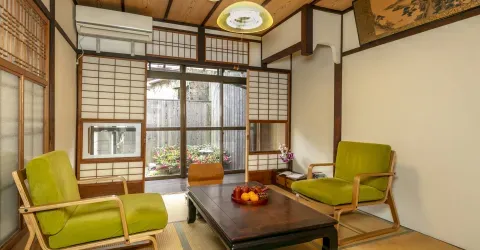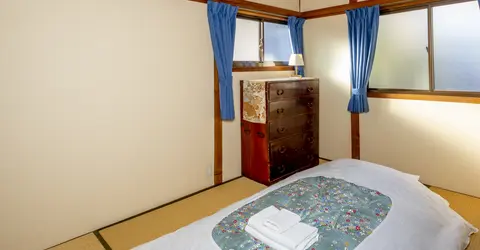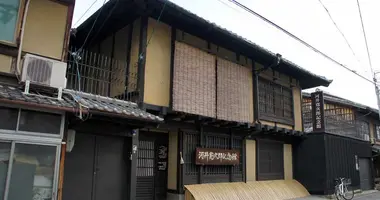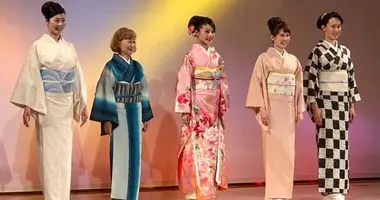Saga Arashiyama Museum of Arts & Culture
Saga Arashiyama Museum of Arts & Culture 嵯峨嵐山文華館

Entrance to the Saga Arashiyama Museum of Arts & Culture, Kyoto
A new museum devoted to traditional Japanese arts and culture has opened in Saga Arashiyama, one of the most visited and popular areas in Kyoto. Close to the riverside and just a stone's throw from the Togetsukyo Bridge, a large modern building and garden is home to the Saga Arashiyama Museum of Arts & Culture.

One room of the permanent exhibition Hyakunin Isshu at the Saga Arashiyama Museum of Arts & Culture

Waka poem by the priest Kisen Hoshi in the Kyakunin Isshu exhibition
Hyakunin Isshu
On the first floor is the museum's permanent exhibition called Hyakunin Isshu, which translates as "One hundred people, one poem each."
The Hyakunin Isshu is a very famous anthology of poems with the full title being Ogura Hyakunin Isshu, Ogura being the name of the area of Kyoto where the anthology was composed.
It is attributed to Fujiwara no Teika in the 13th century who created the anthology to decorate screens of an elite residence. The poems are all Waka, that is to say written in Japanese rather than in Chinese. Waka had a variety of forms but the most common and the style represented in the Hyakunin Isshu is known as Tanka and is composed of syllables in 5-7-5-7-7 groupings.
The poems in the collection span six centuries and include many poems by emperors as well as courtiers and priests. Among the most famous would be Sugawara Michizane (845-903) who would later become deified as Tenjin, the kami of poetry and learning. Also included is Kakinomoto Hitomaro (655-710), the greatest of the ancient poets who are collected in the Manyoshu, the oldest collection of poetry in Japan.
A large percentage of the poets have the family name Fujiwara as they were the most powerful family in Japan during that time. Poems by women are also included with poems by Murasaki Shikibu (978-1014) author of the Tale of Genji, and Sei Shonagon (966-1025) who wrote The Pillow Book.

Two scroll painting illustrating poems from the Ogura Hyakunin Isshu, Saga Arashiyama Museum of Arts & Culture

120 mat main gallery on the second floor of the newly opened Saga Arashiyama Museum of Arts & Culture, Arashiyama, Kyoto
Uta Karuta
Ogura Kyakunin Issho is the most famous of the Japanese poetry anthologies largely due to the invention in the Edo Period of a card game based on the poems. Uta Karuta are sets of 100 cards, one set having the complete poem along with a portrait and name of the poet, and another 100 cards with just the final phrase of each poem. There are variations on the game, but it was, and still is, played over the New Year period for fun among the family, but also competitively with nationwide tournaments.
On display at the museum are some ancient calligraphic examples of the poems and lots of paintings of various types illustrating different poems, but the centerpiece is a big display of all 100 poems that include an English translation and a small figurine of the poet.
On the second floor is a massive tatami-floored exhibition space where changing exhibitions are displayed. Mostly centered around poetry, calligraphy, and paintings, an upcoming exhibition is Travel Japan in Art: Ukiyoe and More.
There is a museum shop and a cafe with both inside and outside seating.

A folding screen exhibited in the huge second floor gallery of Saga Arashiyama Museum of Arts & Culture

Outdoor cafe and garden at Saga Arashiyama Museum of Arts & Culture, Kyoto
Museum & Arashiyama Access
Saga Arashiyama Museum of Arts & Culture
11 Sagatenryuji-Susukinobaba-cho
Ukyo-ku, Kyoto-shi
Kyoto 616-8385
Tel: 075 882 1111
www.samac.jp
Open 10 am to 5 pm. Closed Tuesdays or if Tuesday is a public holiday, closed the next day. The museum is also closed over New Year and while changing exhibitions.
Guided tours in English can be given for groups with advance notice at the telephone number above.
The museum is located on the north bank of the river about 300 meters west of the Togetsukyo Bridge and 200 meters south of Tenryuji Temple.
Admission: 900 yen for adults, 500 yen for high school students, 300 yen for junior high school and elementary students
To get to Arashiyama take the JR San-in Line from Kyoto Station or Nijo Station to JR Saga-Arashiyama Station, the journey takes 12 minutes.
Alternatively take the Keifuku Arashiyama (Randen) Line from Shijo Omiya Station to Keifuku-Arashiyama Station (which is closer) and walk.
Hankyu Arashiyama Station (convenient if coming from Osaka) is south of the river. Cross Togetsukyo Bridge and turn left.
There are also city buses from Kyoto Station to Arashiyama - take bus #28. Alternatively bus #11 runs from Sanjo Keihan Station to Arashiyama and bus #71 from Daikakuji Temple in north west Kyoto to Arashiyama.
Related Arashiyama Articles
Sagano Train & Hozu River Boat Trip
Arashiyama River Cruise Tours
Book Hotel Accommodation in Kyoto Japan
Books on Kyoto Japan
Saga Arashiyama Museum of Arts & Culture, a large modern building and garden in Kyoto, is dedicated to the Hyakunin Isshu - a very famous anthology of classical poems.



























